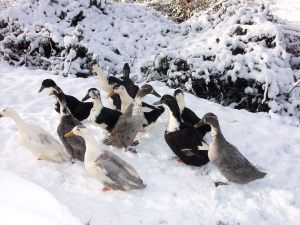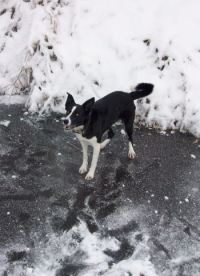 Last year I tried incubating duck eggs twice, and my yields were extremely low. I found that most of the eggs grew to maturity, but never hatched. I concluded that the most likely cause of last year’s poor result was that I incubated in late spring and early summer, when outdoor temperatures were fluctuating wildly. Though I had the incubator in the house, the type of incubator I have is not thermostatically controlled (as far as I can tell)- it’s just controlled by a variable resistor, which you set at the beginning of the incubation period. As the house temperature rose and fell with the weather, I constantly struggled to keep the inside temperature of the incubator correct. So, this year I decided to incubate earlier in the year, when our house temperature remains more stable.
Last year I tried incubating duck eggs twice, and my yields were extremely low. I found that most of the eggs grew to maturity, but never hatched. I concluded that the most likely cause of last year’s poor result was that I incubated in late spring and early summer, when outdoor temperatures were fluctuating wildly. Though I had the incubator in the house, the type of incubator I have is not thermostatically controlled (as far as I can tell)- it’s just controlled by a variable resistor, which you set at the beginning of the incubation period. As the house temperature rose and fell with the weather, I constantly struggled to keep the inside temperature of the incubator correct. So, this year I decided to incubate earlier in the year, when our house temperature remains more stable.
I also theorized that washing the eggs prior to incubation may have been detrimental. Large hatcheries do wash, to cut down on the risk of bacterial contamination on the egg surfaces. But, I figured I’d try mother nature’s approach this time instead. The eggs are naturally coated with a substance that prevents moisture loss, so it’s possible that it’s better to leave that on, despite the added risk of bacteria load. In the photo, you can see how dirty the eggs were. I use an egg-turning device, but this photo was taken after I removed that: the last three days before hatching, you stop turning the eggs so the ducklings can get into position for hatching.
Despite my new attempts, things still didn’t go well! I started out with about 40 eggs, withheld maybe six that didn’t appear fertile at the first candling. But I was expecting a good thirty ducklings out of this batch. What I got: five! A few hatched normally on their own on the due date or one day later. But then, nothing.
 Hopefully this doesn’t sound too mad-scientist, but I cracked a few of them open by the third day of lateness, just to evaluate what was going on. Here is an interesting photo of a duckling in his shell, showing how folded-up they are- his foot is on top of his head! His neck and head are completely torqued around, parallel to his body.
Hopefully this doesn’t sound too mad-scientist, but I cracked a few of them open by the third day of lateness, just to evaluate what was going on. Here is an interesting photo of a duckling in his shell, showing how folded-up they are- his foot is on top of his head! His neck and head are completely torqued around, parallel to his body.
In the upper right of the photo is his bill, and above that is where the air sac area of the egg was. So when they are ready to hatch, a small point on the end of the bill penetrates the membrane of the air cell, they starts to “pip” through the egg shell here. Then the baby will work his bill around the circumference of the shell and essentially crack open a “lid” and exit out of that “hatch” in the top of the egg shell. It’s amazing to think they can do all that maneuvering when they are this cramped in there!
What I found when I cracked these open was still-alive ducklings that had not yet completely absorbed their yolks into their abdomens. So, they were developmentally delayed. I believe this is most likely due to the incubation temperature being too low (though you can see I am using THREE thermometers in there for comparison- and all of them read a little different!).
Interestingly, one of these crack-opens survived just fine, what was left of his external yolk just dried up and scabbed over. But, the other ones, though they were wriggly and peeping for the first few minutes out of their shell, perished soon after.
So I gave the rest of the eggs more time, and one actually did hatch out five days late, but did not survive much after hatching. This seems to confirm what the books say: if they don’t hatch on time, within about 48 hours of when they’re due, forget about it. Just discard them, because whatever is left are weak and malformed birds. And hatch time can be hereditary, so you don’t want to keep and breed birds that don’t hatch on time.
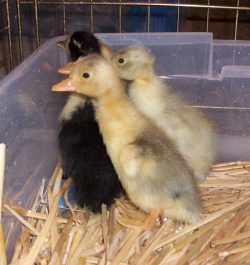 I also wonder if ducks aren’t harder to hatch than chickens? Their eggshells are much, much tougher; so I imagine if the hatchling is weakened at all, he just won’t make it out. And, the tiny point on the end of the duck bill meant for cracking the egg is indeed a very tiny point. Where chicken chicks are blessed with an entire pointy beak- a much better tool for tapping oneself out of an eggshell.
I also wonder if ducks aren’t harder to hatch than chickens? Their eggshells are much, much tougher; so I imagine if the hatchling is weakened at all, he just won’t make it out. And, the tiny point on the end of the duck bill meant for cracking the egg is indeed a very tiny point. Where chicken chicks are blessed with an entire pointy beak- a much better tool for tapping oneself out of an eggshell.
My other suspicion as to what is going on is humidity problems. The ducks that did hatch had trouble. Their shells stuck to them, their eyes were stuck shut, and they were just generally gummed up. We had to wash some of them with warm water to help them. This is not normal, ideally they crack out of their shells pretty cleanly, and are dry and fluffy in few hours.
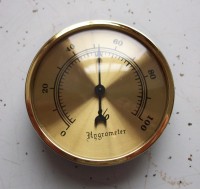 So, I’m going to try again. This time, I calibrated my cheap-o thermometers with our digital oven thermometer, and I do think the cheap-os are reading a little high (which explains why the last batch was late). And I purchased a hygrometer, which measures humidity in the air. I came to realize that these little doodads are inexpensive, and can be obtained at any cigar shop, made for cigar humidors. The cigar-style is just the right size and weight for using inside the incubator, and can just stick on the side.
So, I’m going to try again. This time, I calibrated my cheap-o thermometers with our digital oven thermometer, and I do think the cheap-os are reading a little high (which explains why the last batch was late). And I purchased a hygrometer, which measures humidity in the air. I came to realize that these little doodads are inexpensive, and can be obtained at any cigar shop, made for cigar humidors. The cigar-style is just the right size and weight for using inside the incubator, and can just stick on the side.
So, I’ve got a batch of 36 eggs in there now, humming along at 99.5° at 55% humidity. I’m crossing my fingers that I’ve got it down now!
 I liked my original A-frame
I liked my original A-frame  I built this poultry feeder A-frame a week or so ago. I used old barn wood this time. I don’t often find ways to recycle the barn wood, because it’s so dimensionally gigantic, dense and heavy compared to modern lumber, that even the tiniest structure weighs too much. Right now, we want everything to be move-able since we don’t know where all our permanent structures are going to go. But, this worked ok: made from barn siding and roof pieces, I think it “only” weighs about 50 pounds!
I built this poultry feeder A-frame a week or so ago. I used old barn wood this time. I don’t often find ways to recycle the barn wood, because it’s so dimensionally gigantic, dense and heavy compared to modern lumber, that even the tiniest structure weighs too much. Right now, we want everything to be move-able since we don’t know where all our permanent structures are going to go. But, this worked ok: made from barn siding and roof pieces, I think it “only” weighs about 50 pounds! Wow, we have a lot of snow– at least for us. I think it’s about a foot deep. Which, I’m sure, seems trivial to people in the Midwest or the East. But in the Northwest, that is a ton– I don’t have many memories of there being this much snow here in my lifetime. We’ve had snow falling for the last week, and more in the forecast for the whole next week- incredible! Usually it doesn’t stick around more than a day or two before melting into a muddy slop. Here is a panoramic photo from the pasture, in which Maggie appears twice– she got in the frame more than once!
Wow, we have a lot of snow– at least for us. I think it’s about a foot deep. Which, I’m sure, seems trivial to people in the Midwest or the East. But in the Northwest, that is a ton– I don’t have many memories of there being this much snow here in my lifetime. We’ve had snow falling for the last week, and more in the forecast for the whole next week- incredible! Usually it doesn’t stick around more than a day or two before melting into a muddy slop. Here is a panoramic photo from the pasture, in which Maggie appears twice– she got in the frame more than once!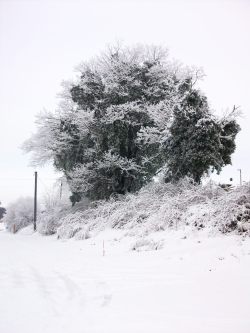 The temperatures aren’t bad– a few days it’s gotten into the teens, but it’s mostly hovering right around freezing. We got our first official complaint to animal control about our animals- from a well-meaning citizen who felt concerned for them. An animal control officer came out to investigate, and chuckled to himself, “well, the DO have wool, after all!” A friend of mine teased me that we should get wool coats for them!
The temperatures aren’t bad– a few days it’s gotten into the teens, but it’s mostly hovering right around freezing. We got our first official complaint to animal control about our animals- from a well-meaning citizen who felt concerned for them. An animal control officer came out to investigate, and chuckled to himself, “well, the DO have wool, after all!” A friend of mine teased me that we should get wool coats for them!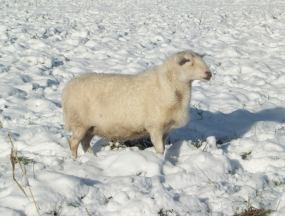 They really look like they’ve grown more wool in the last week or two, they are quite bundled up and puffy. The llama has so much wool insulating her that snow accumulates on her back and stays there– it doesn’t melt! Once a day I break the ice out of their trough with a pickaxe, though I suspect they are getting their water from eating snow and not going to the trough.
They really look like they’ve grown more wool in the last week or two, they are quite bundled up and puffy. The llama has so much wool insulating her that snow accumulates on her back and stays there– it doesn’t melt! Once a day I break the ice out of their trough with a pickaxe, though I suspect they are getting their water from eating snow and not going to the trough.